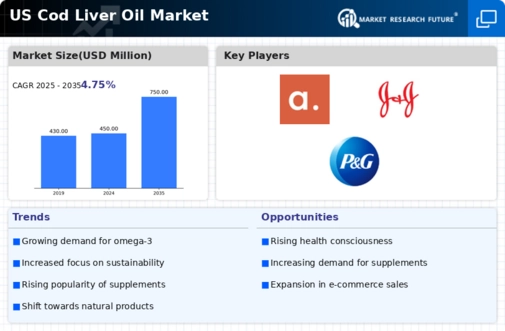Influence of Dietary Trends
Current dietary trends, such as the ketogenic and paleo diets, are impacting the cod liver-oil market. These diets emphasize high-fat, low-carbohydrate food sources, which align well with the nutritional profile of cod liver oil. As more individuals adopt these dietary patterns, the demand for supplements that complement these lifestyles is likely to increase. The cod liver-oil market is capitalizing on this trend by marketing its products as ideal for those following such diets, highlighting their benefits in supporting fat metabolism and overall health. Market analysis indicates that the popularity of these diets has led to a 20% increase in sales of high-fat supplements, including cod liver oil, over the past year. This trend suggests a promising future for the cod liver oil segment as it aligns with evolving consumer preferences.
Expansion of Retail Channels
The expansion of retail channels is significantly influencing the cod liver-oil market. Traditional brick-and-mortar stores are increasingly complemented by online platforms, making it easier for consumers to access a variety of cod liver oil products. This trend is particularly relevant in the US, where e-commerce sales of dietary supplements have surged, accounting for nearly 30% of total sales in the sector. The cod liver-oil market is benefiting from this shift, as online retailers offer convenience and often competitive pricing. Additionally, the presence of subscription services for health products is emerging, providing consumers with regular deliveries of their preferred supplements. This accessibility is likely to enhance consumer engagement and loyalty, contributing to sustained growth in the market.
Rising Interest in Natural Supplements
There is a notable shift towards natural and organic supplements, which is positively impacting the cod liver-oil market. Consumers are becoming more discerning about the ingredients in their dietary supplements, favoring products that are minimally processed and free from artificial additives. This trend aligns with a broader movement towards holistic health and wellness, where individuals prioritize natural sources of nutrients. The cod liver-oil market is adapting by sourcing high-quality, sustainably harvested cod liver oil, which appeals to environmentally conscious consumers. Market data indicates that sales of natural supplements have increased by approximately 15% in the past year, underscoring the growing preference for products perceived as safe and effective. This shift is likely to continue, further driving the demand for cod liver oil as a trusted natural supplement.
Increased Demand for Omega-3 Fatty Acids
The growing awareness of the health benefits associated with omega-3 fatty acids is driving the cod liver-oil market. Consumers are increasingly seeking dietary supplements that support heart health, cognitive function, and overall wellness. According to recent surveys, approximately 70% of consumers in the US are aware of the importance of omega-3s, leading to a surge in demand for cod liver oil products. This trend is particularly pronounced among health-conscious individuals and those with specific dietary needs. The cod liver-oil market is responding by expanding product lines to include flavored options and formulations that cater to various age groups, thereby enhancing accessibility and appeal. As a result, the market is projected to grow at a CAGR of around 5% over the next few years, reflecting the increasing consumer inclination towards omega-3 supplementation.
Growing Awareness of Nutritional Deficiencies
The increasing recognition of nutritional deficiencies among the US population is driving interest in dietary supplements, including cod liver oil. Many individuals are becoming aware of the potential health risks associated with deficiencies in essential nutrients, such as vitamins A and D, which are abundant in cod liver oil. This awareness is prompting consumers to seek out supplements that can help bridge dietary gaps. The cod liver-oil market is responding by emphasizing the nutritional benefits of its products, particularly in educational campaigns aimed at informing consumers about the importance of these vitamins for immune function and bone health. Recent studies suggest that nearly 40% of adults in the US may be deficient in vitamin D, further highlighting the potential for growth in the cod liver oil segment as consumers look for effective solutions.














Leave a Comment